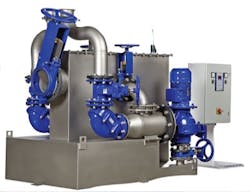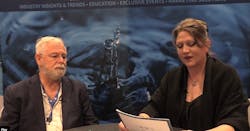Waterways study wins recognition for Metropolitan Water Reclamation District
Richard Lanyon, retired MWRD Executive Director, Dr. Geeta Rijal, MWRD Supervising Environmental Microbiologist and Dr. Cecil Lue-Hing, retired MWRD Director of Monitoring and Research, accepted the grand prize for university research at the annual American Academy of Environmental Engineers conference held at the National Press Club in Washington, DC, last month.
May 17, 2012 -- At its conference last month, the American Academy of Environmental Engineers awarded a grand prize for university research to the Metropolitan Water Reclamation District of Greater Chicago (MWRD).
The MWRD funded the award-winning University of Illinois at Chicago (UIC) research, which focused on the health risks associated with recreating on the Chicago Area Waterway System (CAWS). MWRD Monitoring and Research Director Dr. Thomas Granato directed the study parameters, and Dr. Samuel Dorevitch, Associate Professor of Environmental & Occupational Health Sciences at the UIC School of Public Health, conducted the three-year epidemiologic study. He based the research on the U.S. EPA National Epidemiological and Environmental Assessment of Recreational Water study.
"Few wastewater treatment agencies make research a priority in the way that the MWRD does," said Dr. Dorevitch. "It's been challenging and interesting to work on a health study of this scale that addresses a local environmental policy decision. It's rewarding to see the findings published so that others in the community of water quality researchers can learn from the work we've done."
MWRD Commissioner Mariyana Spyropoulos, chairman of the Monitoring and Research Committee, recognized the unique nature of the study. "The CHEERS study was the first in the country to address the health risks to individuals who engaged in incidental contact water recreational activities such as boating, fishing and rowing," Commissioner Spyropoulos explained.
The health information of the recreating participant was compared with water quality tests for indicators and pathogens during the same time at the CAWS, Lake Michigan and other rivers and inland lake locations.
"We assembled a world class team of dedicated researchers with a novel approach to assessing public health impacts of surface water quality," said Dr. Granato. "The team at UIC worked many long days and weekends to complete this study, and their work product is world class."
Dr. Geeta Rijal, MWRD Supervising Environmental Microbiologist, said the study was driven by the quest for the great unknown about the current health risks to people recreating on the CAWS. "CHEERS produced the best public health microbiology science for secondary contact," said Dr. Rijal.
The CAWS includes the Cal-Sag Channel, the North and South Branches of the Chicago River, the Main Stem of the Chicago River, and the North Shore Channel. The system was designed to connect Lake Michigan to the Illinois River via the Des Plaines River, and just as it was planned, the system is used for transportation, commerce, and to convey stormwater away from Lake Michigan, the source of the Chicago area's drinking water. In recent years, recreation has become an increasingly popular use of the system.
Wastewater treatment plants release treated wastewater into the CAWS, and the CHEERS research study was conducted to better understand the benefits that might be realized if the MWRD resumed disinfection of wastewater effluents at its North Side and Calumet water reclamation plants (WRPs) and to determine appropriate water quality criteria to protect secondary contact recreation. Since the study was conducted, MWRD's Commissioners have instituted a policy to implement disinfection at the North Side and Calumet WRPs, and engineering designs are currently being developed.
"The MWRD is well known for developing the science on issues through productive collaboration, and this study adds to a rich body of work," said David St. Pierre, MWRD executive director. "We are thrilled that the MWRD and UIC received this prestigious recognition."
The study surveyed over 11,000 participants at CHEERS recruiting stations strategically located near boat launches and other high profile locations where water recreation takes place along the CAWS; waterbodies included Lake Michigan the Des Plaines, DuPage, and Fox Rivers, inland lakes and lagoons, Busse Lake, Tampier Lake, and the Skokie Lagoons. Water bacteria, viruses, and germs were tested.
Study participants were contacted three times over three weeks to check on their health status. If a participant developed an ailment, they were asked to provide further information for testing.
The study found that secondary contact recreation on the CAWS is not any riskier than on other nearby rivers or lakes. This will be further improved when disinfection is implemented.
About MWRDEstablished in 1889, the MWRD is an award-winning, special purpose government agency responsible for wastewater treatment and stormwater management in Cook County, Illinois. Visit our website at www.mwrd.org.
###



